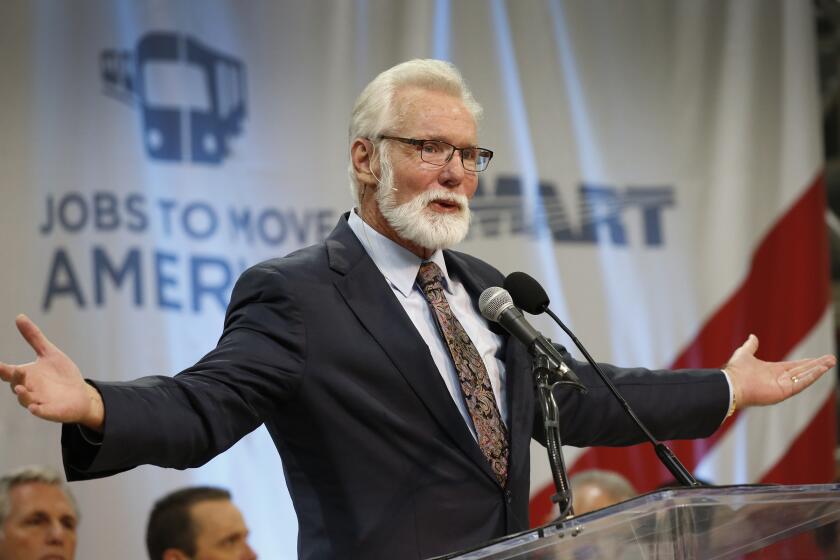Separating water and politics isn’t easy in California
- Share via
The 2014 water bond included a novel funding approach designed to take at least some of the politicking out of deciding which projects get public money.
This week’s tortured deliberations by the California Water Commission showed just how tough it is to do that.
By applying a complex procedure for grading proposals, the bond restricted state taxpayer spending to the pieces of a project that would provide measurable benefits to the public.
Commissioners struggled mightily with that formula as it become obvious that certain proposals were headed for little or no funding.
“This is extremely uncomfortable,” commission chairman Armando Quintero of San Rafael conceded.
“To be here today and be in a position, where as much as we want to move this project forward, we can’t — that is extremely hard,” said commissioner Maria Herrera of Visalia.
“It would be tragic if the project died in this room tonight,” commissioner Joe Del Bosque lamented as the panel prepared to vote on the Temperance Flat proposal to build a new dam and reservoir on the upper San Joaquin River.
The commission, whose members are appointed by Gov. Jerry Brown, capped three exhausting days of hearings with a round of votes Thursday that determined project funding eligibility. The panel won’t make final awards until July.
The $2.6-billion Temperance Flat project was deemed eligible for only $171 million. The $5.1-billion Sites proposal to construct an off-stream dam and reservoir in the Sacramento Valley fared better with $1 billion. But that still fell nearly $400 million short of proponents’ original request.
It was clear from the onset that the 11 water storage proposals competing for state money wouldn’t get all they wanted. Their requests amounted to nearly double the $2.7 billion set aside for storage in the 2014 bond, known as Proposition 1.
The projects, from around the state, spanned the storage spectrum. They included expanding existing reservoirs in the Bay Area, storing recycled water in a San Diego County reservoir and capturing Kings River floodwaters to recharge San Joaquin Valley groundwater basins.
The commission concluded the San Diego, Kings River and one other project failed to meet the bond requirements and weren’t eligible for any state money.
Temperance Flat advocates, who had requested roughly $1 billion, suffered a major setback for a reservoir long sought by San Joaquin Valley growers.
“There is no easy road,” Mario Santoyo, executive director of the San Joaquin Valley Water Infrastructure Authority, said Friday. “I would fully expect our priority will be to engage with the Trump administration to secure more dollars.”
The Sites project enjoys more widespread political support than Temperance Flat. But both dam proposals ran into trouble meeting the requirements of the complicated funding formula outlined in voter-approved Proposition 1.
The measure mandates that the state in most cases pay for no more than half of a project’s total cost. And the state money can be used only to underwrite a project’s public benefits, such as recreation, flood control and ecosystem improvements.
Additionally, half of the state share has to pay for ecosystem improvements in the watershed of the Sacramento-San Joaquin Delta, the environmentally troubled center of California’s water delivery system.
State agencies reviewed the applications to determine if — and to what extent — the projects met those requirements.
The state Fish and Wildlife Department rejected claims that the Sites and Temperance Flat projects would improve conditions for imperiled salmon runs. That especially hurt Temperance Flat’s funding chances.
Commissioners repeatedly grilled — and sometimes challenged — the economic consultant and state agency staffers on their funding recommendations.
“How do you get zero?” asked Del Bosque, a San Joaquin Valley grower, referring to the finding that Temperance Flat wouldn’t provide any benefit to the Chinook salmon run the federal government is trying to return to the San Joaquin River.
Again and again, Kristal Davis-Fadtke, a Fish and Wildlife Department senior scientist, told the commissioners the same thing: “The applicant has not demonstrated a net benefit.”
Clearly unhappy with some of the staff recommendations, commissioner Andrew Ball of Berkeley said he refused “to be a rubber stamp” for other agencies. “The public is demanding we should move forward” on funding new water storage, he said.
Joe Yun, the commission’s executive officer, pointed out that it would be legally risky to depart from the regulatory framework established by the bond. “If you just ignore what the agencies have told you and what’s on the record, I think that’s a very short road,” he said.
Commission vice chair Carol Baker of Sacramento similarly said the panel didn’t have much wiggle room. “We have some areas of flexibility. But for the most part we are bound within the law and regulation.”
Ultimately, the commission voted 4 to 3 to accept the staff recommendations on the Temperance Flat and Sites funding. Commissioner Daniel Curtin of Sacramento, who earlier in the hearings pushed to give more money to many of the projects, was absent for the Thursday votes.
The commission approved full funding requests from several projects. Those include expansions of the Los Vaqueros and Pacheco reservoirs in the Bay Area and a Sacramento County project that would use recycled water to irrigate crop land and recharge the regional aquifer.
A Southern California proposal to expand the Chino Basin water recycling program and reduce the basin’s use of imported delta supplies was approved for roughly half its original request.
The challenge of California water “is that we expect more than there is to get,” said Doug Obegi, a Natural Resources Defense Council attorney who attended the hearings.
“Prop 1 tried to depoliticize that by making it about specific public benefits. But over and over again you saw the commission struggling with the broader implications.”
Twitter: @boxall
More to Read
Sign up for Essential California
The most important California stories and recommendations in your inbox every morning.
You may occasionally receive promotional content from the Los Angeles Times.











